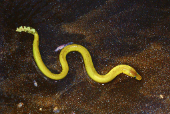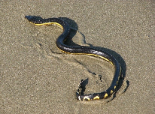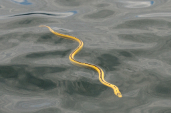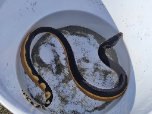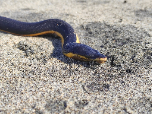Yellow-Bellied Sea Snake (Hydrophis platurus)
Description: The yellow-bellied sea snake, as the name implies, has a distinctive bicolor pattern with a yellow underbelly and brown back, making it easily distinguishable from other sea snake species. Dark brown or black with a bright yellow or pale yellow underside which extends up the sides.
Sometimes the underside is darker, sometimes a snake is all yellow or yellow with a narrow black stripe on the back. The tail is marked with black spots or bars. The maximum length of this sea snake is 113 cm. Adaptations to aquatic life include the reduced ventral scale size, laterally compressed body and paddle-tail for swimming, valved nostrils and palatine seal for excluding seawater, and cutaneous gas exchange for prolonging dive times.
Habitat: Habitats include the open ocean and coastal waters of tropical and subtropical warm oceans. In some areas this snake is most often observed near the coast in shallower inshore waters, in water of 22-30 C. Often it is at or near the surface in association with flotsam; it dives to at least 15 meters. Births occur in the ocean or possibly in habitats such as mangrove swamps
Range: The yellow-bellied sea snake has an extensive distribution covering the entire tropical Indo-Pacific, as well as extending to Costa Rica, southern California, and northern Peru. It is the only sea snake to have reached the Hawaiian Islands.
Found in these States:
CA |
HI
Venom: The venom of this species is highly potent, like that of other sea snakes. The subcutaneous LD50 of the venom is 0.067 mg/kg and the venom yield per bite is 1.0–4.0 mg. Yellow-bellied sea snake venom contains several different neurotoxins and two other isotoxins.
Diet: They are sometimes observed in large aggregations of thousands on the surface of the water in oceanic drift lines, which has been proposed as a strategy to catch prey. They hunt by floating on the surface of the water to attract pelagic fish that are seeking shelter; prey are captured via a backwards swimming motion and rapid lunge of the jaws. The ability to swim backwards is an unusual and distinguishing characteristic of this species. Heatwole proposed that these snakes find their prey by sensing the vibration generated by fish movement.
Reproduction: Yellow-bellied sea snakes breed in warm waters; they are ovoviviparous with a gestation period around 6 months. According to Ditmars, females bear live young in tidal pools. They move poorly on land due to their smaller belly scales that form a ventral keel.
Status: This is the most widely distributed sea snake species. There are some threats, but none thought to be major and the population is most likely stable. This species is listed as Least Concern.
Subspecies: Two:
Common Yellow-bellied Sea Snake - (Hydrophis platurus platurus)
Yellow Sea Snake - (Hydrophis platurus xanthos)
»» Kingdom: Animalia - Animals
»» Phylum: Chordata - Chordates
»» Subphylum: Vertebrata - Vertebrates
»» Class: Reptilia - Reptiles
»» Order: Squamata - Scaled Reptiles
»» Suborder: Serpentes
»» Superfamily: Elapoidea
»» Family: Eplaidae - Elapids
»» Genus: Hydrophis
»» Species: Hydrophis platurus - Yellow-Bellied Sea Snake
»» Subspecies:
»» Hydrophis platurus platurus - Common Yellow-bellied Sea Snake
»» Hydrophis platurus xanthos - Yellow Sea Snake
This article uses material from the Wikipedia article "Yellow-Bellied Sea Snake", which is released under the Creative Commons Attribution-Share-Alike License 3.0. Content may have been omitted from the original, but no content has been changed or extended.
|



